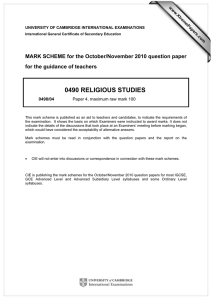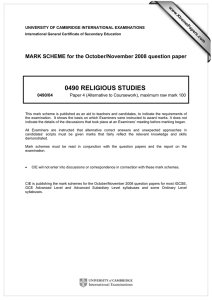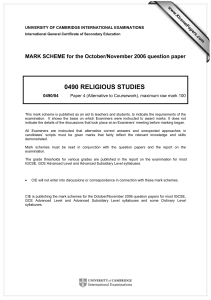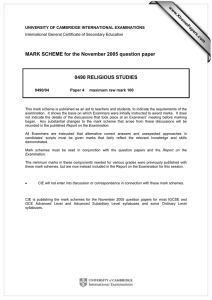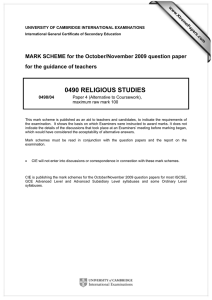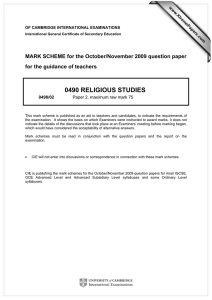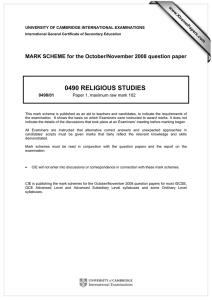0490 RELIGIOUS STUDIES MARK SCHEME for the October/November 2007 question paper
advertisement
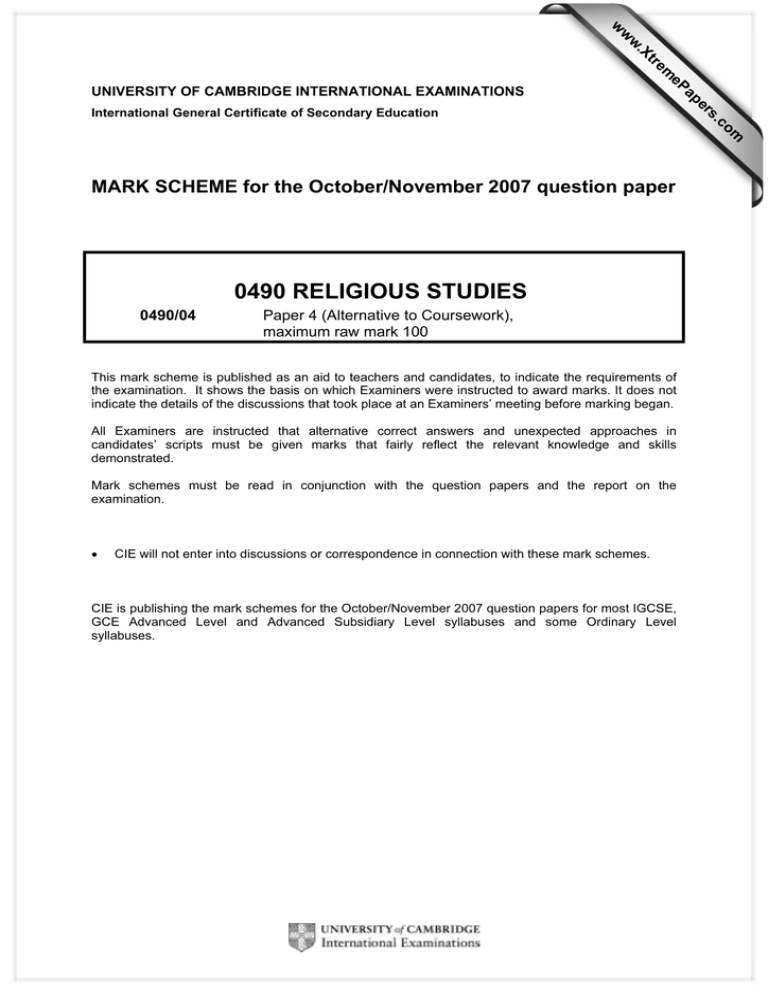
w w ap eP m e tr .X w UNIVERSITY OF CAMBRIDGE INTERNATIONAL EXAMINATIONS 0490 RELIGIOUS STUDIES 0490/04 Paper 4 (Alternative to Coursework), maximum raw mark 100 This mark scheme is published as an aid to teachers and candidates, to indicate the requirements of the examination. It shows the basis on which Examiners were instructed to award marks. It does not indicate the details of the discussions that took place at an Examiners’ meeting before marking began. All Examiners are instructed that alternative correct answers and unexpected approaches in candidates’ scripts must be given marks that fairly reflect the relevant knowledge and skills demonstrated. Mark schemes must be read in conjunction with the question papers and the report on the examination. • CIE will not enter into discussions or correspondence in connection with these mark schemes. CIE is publishing the mark schemes for the October/November 2007 question papers for most IGCSE, GCE Advanced Level and Advanced Subsidiary Level syllabuses and some Ordinary Level syllabuses. om .c MARK SCHEME for the October/November 2007 question paper s er International General Certificate of Secondary Education Page 2 Mark Scheme IGCSE – October/November 2007 Syllabus 0490 Paper 04 Marking Criteria As the nature of this paper is the assessment of candidates’ individual responses to sources/stimuli presented without specific guidance as to the expected approaches, a detailed mark scheme is not appropriate and markers must assess the responses on their own merits according to the Marking Criteria and not allow their judgement to be affected by any pre-conceived idea of ‘correct’ responses. Areas which candidates might explore include the suggestions below. Marks should be awarded according to the following criteria for each Assessment Objective. The envisaged levels are very general and will need to be interpreted as appropriate to the requirements of the question when applied to particular answers. Question 1 Assessment Objective A Question 2 Assessment Objective A Question 3 Assessment Objective A [10 marks] [15 marks] [10 marks] Total marks Level 1 Level 2 Level 3 Level 4 10 1–3 4–6 7–8 9–10 15 1–4 5–8 9–12 13–15 Assessment Objective A: Knowledge Level 1: some attempt to deal with the task. The inclusion of a small amount of relevant information. Limited ability to organise work or present an argument. Level 2: a basic attempt to deal with the task. Some of the relevant information will have been selected with evidence of organisation. Level 3: a reasonable attempt to deal with the task. Salient information selected, organised and presented with some skill. Level 4: an excellent attempt to respond to the task in an individual way. The work will be presented in a clear, coherent manner. © UCLES 2007 Page 3 1 Mark Scheme IGCSE – October/November 2007 Syllabus 0490 Read Source F. What is this passage encouraging people to do? Paper 04 [10] Candidates who re-state the source in their own words ‘having selected salient information with some skill’ merit Level 3; Level 2 if there is not much selection. Level 4 for ‘an excellent attempt to respond to the task in an individual way’ which should include the recognition that the core of the passage is the ‘call to action’. 2 State in your own words the religious teachings about helping the poor which are given in each of Sources A, B and C. [15] The three passages are overtly about the religious duty to support the poor, but A and C have the additional message that God will reward those who do so – candidates who mention this will probably merit Level 4. A basic answer may just reproduce the candidates’ memorised material without application to the passage – this will be awarded a maximum of Level 2. To gain Level 4, answers must consider, however briefly, all three passages. The question does not specifically require three separate sections to the answer and indeed a good synthesis would merit a high level. Candidates who work through each faith and give a simple explanation of the teachings contained in the passages can gain Level 3 if the answers are ‘organised and presented with some skill’. 3 Read Sources D and E. What points do these passages make about the religious benefits of giving to the poor? [10] D: the first part states that the poor are blessed and will receive a reward in the life to come; the corollary of this is that those who are rich and comfortable now will not receive any such reward. Those who give away all their wealth and become poor themselves will receive a reward in heaven. A reference to the rich young man in Source A would contribute to raising the level of an answer but is not required for Level 4. E: Islam is explicit about the benefits to the giver, particularly the secret giver who goes beyond the requirements of zakah. Allah knoweth it. One of the benefits is atonement for sins. Candidates do not need to separate their answers into two parts, and a generalised response covering both passages is acceptable. As this is an AO1 question, Level 4 is available to those who make a good attempt at paraphrasing the passages. © UCLES 2007 Page 4 Mark Scheme IGCSE – October/November 2007 Syllabus 0490 Paper 04 Assessment Objective B: Understanding and Interpretation Level 1, mark range 1–10: limited understanding of religious language and concepts, with facts often presented as understanding. There will be few explanations offered. Limited ability to recognise the relationship between an issue and the study of religion. Level 2, mark range 11–20: some understanding of religious language and concepts although lacking in depth. Some ability to recognise the relationship between religious belief and practice. The ability to make simple comparisons and recognise similarities and differences. Level 3, mark range 21–30: a wider, more mature level of understanding of religious language and concepts. The ability to recognise the relationship between religious beliefs and practice. The ability to recognise and handle religious issues. Level 4, mark range 31–40: the demonstration of a thorough understanding of religious language and concepts. Clear explanations of the relationship between religious beliefs and practice. Confidence in the recognition and handling of religious issues. 4 Read Sources G, H and I and look at Sources J, K and L. Explain the religious attitudes about giving to charity which they show. [40] Candidates may write either about each of the sources in turn, or write a coherent extended answer which draws on all of the sources. The overall theme is intended to be the religious basis for organised charitable giving, not ignoring the benefits to the believer/giver. Better answers may make the connection between abstract teaching about the need for charitable giving and the way it is formalised and organised within religious communities i.e. ‘clear explanations of the relationship between religious beliefs and practice’. Level 4 answers are likely to have mentioned (explicitly or implicitly) all the sources. © UCLES 2007 Page 5 Mark Scheme IGCSE – October/November 2007 Syllabus 0490 Paper 04 Assessment Objective C: Evaluation and Investigation Level 1, mark range 1–6: a statement of the obvious, a one-sided judgement with little or no argument. Level 2, mark range 7–12: a clearly expressed opinion based on the evidence, with an argument offered in support. Level 3, mark range 13–18: the ability to recognise some of the significance of the issue raised. The clear expression of an opinion directly related to the information presented and supported by evidence and argument. An awareness of the existence of different opinions. Level 4, mark range 19–25: the ability to recognise the complexity of issues raised and to express valid opinions about different points of view, well supported by evidence and argument. 5 Look at all the Sources. Do you think that religious people should make bigger donations to charity than non-believers? Give reasons for your answer. [25] Candidates’ answers will cover a broad spectrum of responses in greater or lesser depth and breadth, for or against religious teachings. Candidates may concentrate on the teachings of one religion if they wish, but this is neither required nor excluded. Any view must be credited in accordance with the Levels of Response. The ‘Investigation’ aspect of the Assessment Objective will be met by use of the provided sources; extra knowledge may be rewarded in the overall assessment but is not itself required for the highest levels. © UCLES 2007
